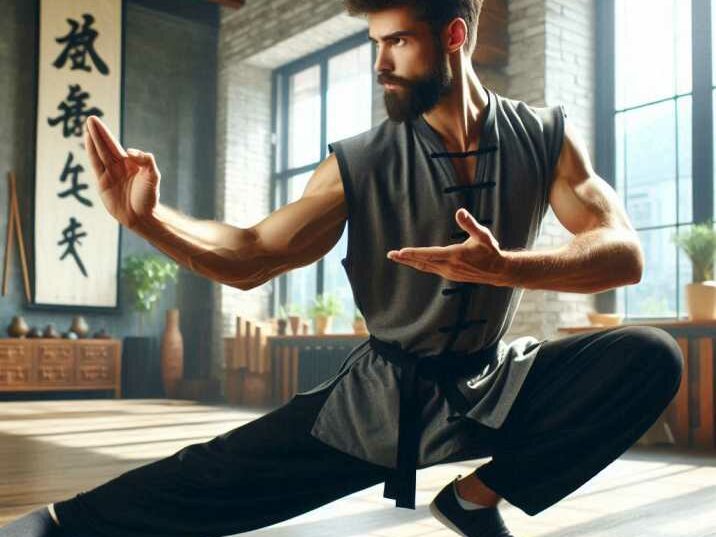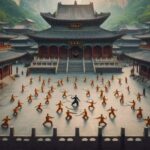Introduction
Table of Contents
When we think of martial arts, images of powerful kicks, punches, and graceful moves often come to mind. But is Kung Fu and martial arts the same thing? Many people use the terms interchangeably, but there’s more to these practices than meets the eye. Understanding the distinctions between Kung Fu and martial arts can help us appreciate their unique histories, techniques, and philosophies.

What is Martial Arts?
Martial arts encompass a wide range of practices and traditions that focus on physical combat and self-defense. Originating from various parts of the world, martial arts include disciplines like Karate from Japan, Taekwondo from Korea, Judo, Brazilian Jiu-Jitsu, and many more. These arts often involve a combination of physical techniques such as strikes, kicks, blocks, and grappling, along with mental discipline and philosophical teachings.
Key Elements of Martial Arts
- Techniques: Martial arts techniques vary widely depending on the style. Striking styles like Karate and Taekwondo focus on powerful punches and kicks, while grappling arts like Judo and Brazilian Jiu-Jitsu emphasize throws and ground control.
- Philosophy: Many martial arts are deeply rooted in philosophy and ethics. For example, Karate emphasizes the principles of respect, discipline, and perseverance.
- Cultural Origins: Each martial art has its unique cultural background, shaping its techniques, training methods, and values.
What is Kung Fu?
Kung Fu is a term that broadly refers to martial arts originating in China. The term “Kung Fu” (or “Gong Fu”) translates to “skill achieved through hard work.” Chinese martial arts have a long history, dating back thousands of years, and they are known for their diverse styles and techniques.
Key Elements of Kung Fu
- Techniques: Kung Fu styles are characterized by their fluid and dynamic movements. They often incorporate acrobatics, flexibility, and a wide range of strikes, kicks, and blocks.
- Philosophy: Kung Fu is heavily influenced by Chinese philosophy, particularly Confucianism, Taoism, and Buddhism. These philosophies emphasize harmony, balance, and the cultivation of inner strength.
- Styles: There are hundreds of Kung Fu styles, each with its unique techniques and forms. Some of the most famous include Shaolin Kung Fu, Wing Chun, and Tai Chi.
Comparing Kung Fu and Martial Arts
To understand whether Kung Fu and martial arts are the same, let’s delve into their similarities and differences.
Similarities
- Self-Defense: Both Kung Fu and martial arts aim to teach self-defense techniques that can be used in real-life situations.
- Physical Fitness: Practicing these arts helps improve physical fitness, including strength, flexibility, and endurance.
- Mental Discipline: Both emphasize mental discipline, focus, and the development of inner strength and character.
- Cultural Significance: Each has a rich cultural heritage and history, deeply embedded in the traditions of their respective origins.
Differences
- Origin: Kung Fu originates from China, while martial arts come from various regions around the world. This diverse geographical origin gives martial arts a wide variety of techniques, styles, and philosophies.
- Techniques: Kung Fu techniques are often more fluid and acrobatic. They involve intricate movements that require flexibility and agility. In contrast, martial arts techniques can range significantly, from the striking techniques of Karate to the grappling methods of Brazilian Jiu-Jitsu.
- Philosophy: Kung Fu is deeply rooted in Chinese philosophical traditions such as Confucianism, Taoism, and Buddhism. These philosophies emphasize harmony, balance, and inner strength. Other martial arts follow different philosophical teachings based on their cultural origins. For example, Karate follows the principles of Bushido, which emphasizes honor and discipline, while Brazilian Jiu-Jitsu focuses on leverage and technique.
- Training Focus: Kung Fu often emphasizes traditional forms and self-discipline. Training includes learning intricate forms, practicing fluid movements, and developing mental focus. Some martial arts may focus more on sport and competition. For example, Taekwondo has a strong emphasis on Olympic-style sparring, and Judo is practiced both as a competitive sport and a traditional martial art.
The Cultural Impact of Kung Fu and Martial Arts
Both Kung Fu and martial arts have made significant cultural impacts worldwide. From movies to sports, their influence is undeniable.
Kung Fu in Popular Culture
Kung Fu has been popularized globally through movies featuring iconic actors like Bruce Lee, Jet Li, and Jackie Chan. These films showcase the beauty and complexity of Kung Fu techniques, capturing the imagination of audiences everywhere. For instance, Bruce Lee’s movies in the 1970s brought international attention to Kung Fu, highlighting its speed, power, and philosophical depth. Jackie Chan’s films, known for their combination of comedy and action, have also played a significant role in popularizing Kung Fu.
Martial Arts in Sports
Martial arts have a strong presence in sports, particularly in mixed martial arts (MMA). MMA combines techniques from various martial arts, including Brazilian Jiu-Jitsu, Muay Thai, and Boxing, to create a versatile and competitive sport. This sport has gained immense popularity through organizations like the Ultimate Fighting Championship (UFC), where fighters showcase their skills in highly publicized events.
Additionally, martial arts like Taekwondo and Judo are featured in the Olympics, highlighting their global appeal. Taekwondo, for example, became an Olympic sport in 2000, and its fast, high-flying kicks have captivated audiences worldwide. Judo has been an Olympic sport since 1964, and its emphasis on throws and grappling techniques has made it a favorite among martial arts enthusiasts.
Training and Practice
The training methods for Kung Fu and martial arts can differ significantly, reflecting their unique philosophies and techniques.
Kung Fu Training
Kung Fu training often involves learning traditional forms or “katas,” which are sequences of movements that simulate combat scenarios. These forms help practitioners develop precision, flexibility, and coordination. Training also includes conditioning exercises, sparring, and the use of traditional Chinese weapons such as swords, staffs, and spears. The focus on forms and traditional weapons sets Kung Fu apart from many other martial arts.
Martial Arts Training
Martial arts training varies widely depending on the style. For example, Karate training focuses on kihon (basics), kata (forms), and kumite (sparring). Students practice powerful strikes, blocks, and kicks, emphasizing proper form and technique. Brazilian Jiu-Jitsu emphasizes ground fighting techniques and live sparring, where practitioners learn to control and submit their opponents using leverage and technique. Taekwondo training includes patterns (poomsae), sparring, and breaking techniques, with a strong focus on high, fast kicks and agility.

Philosophical Foundations
The philosophical foundations of Kung Fu and martial arts play a crucial role in shaping their practices and teachings.
Kung Fu Philosophy
Kung Fu is deeply intertwined with Chinese philosophy, particularly Taoism and Buddhism. Taoism emphasizes living in harmony with the Tao (the Way), promoting balance and inner peace. This philosophy teaches practitioners to flow with the natural order of things, much like the fluid movements in Kung Fu. Buddhism focuses on mindfulness and the cultivation of wisdom and compassion. These philosophical teachings encourage Kung Fu practitioners to develop not only their physical abilities but also their mental and spiritual well-being.
Martial Arts Philosophy
Martial arts philosophies can vary widely. For instance, Karate follows the principles of Bushido, the “way of the warrior,” which emphasizes honor, respect, and discipline. Practitioners are taught to uphold these values both in training and in daily life. Brazilian Jiu-Jitsu promotes the concept of leverage and technique over brute strength, encouraging practitioners to use skill and strategy to overcome opponents. This philosophy teaches humility and perseverance, as practitioners must continually refine their techniques and adapt to new challenges.
Table of Information about Is Kung Fu and Martial Arts the Same?
| Aspect | Kung Fu | Martial Arts |
|---|---|---|
| Origin | China | Various regions (Japan, Korea, Brazil, etc.) |
| Philosophy | Strongly rooted in Chinese philosophy | Diverse philosophies depending on style |
| Techniques | Emphasizes fluidity and flexibility | Varies greatly (striking, grappling, etc.) |
| Famous Styles | Shaolin, Wing Chun, Tai Chi | Karate, Taekwondo, Judo, Brazilian Jiu-Jitsu |
| Popular Culture | Movies with Bruce Lee, Jet Li, Jackie Chan | MMA, Olympic sports |
| Training Focus | Traditional forms and self-discipline | Can include sport-focused training |
| Weapons | Traditional Chinese weapons (swords, staffs) | Varies by style (nunchaku, katana, etc.) |
Conclusion
So, is Kung Fu and martial arts the same? While Kung Fu is a type of martial art, it is distinct in its origins, techniques, and philosophies. Understanding these differences helps us appreciate the rich diversity within the world of martial arts. Whether you’re drawn to the fluid movements of Kung Fu or the varied techniques of other martial arts, both offer valuable lessons in self-defense, physical fitness, and mental discipline.
FAQs
1. Is Kung Fu a type of martial art?
Yes, Kung Fu is a type of martial art that originated in China. It includes various styles and techniques that emphasize fluidity and traditional Chinese philosophy.
2. Are all martial arts the same?
No, martial arts encompass a wide range of styles and techniques from different cultures. Each martial art has its unique characteristics, philosophy, and training methods.
3. Can children learn Kung Fu or other martial arts?
Absolutely! Many martial arts schools offer classes specifically designed for children. Learning martial arts can help kids develop physical fitness, discipline, and confidence.
4. What is the main difference between Kung Fu and Karate?
Kung Fu originates from China and often features fluid, acrobatic movements. Karate, on the other hand, comes from Japan and focuses on powerful strikes and disciplined training methods.
5. Is Kung Fu effective for self-defense?
Yes, Kung Fu can be very effective for self-defense. It teaches a variety of techniques that can be used in real-life situations, and its training often includes practical self-defense scenarios.


